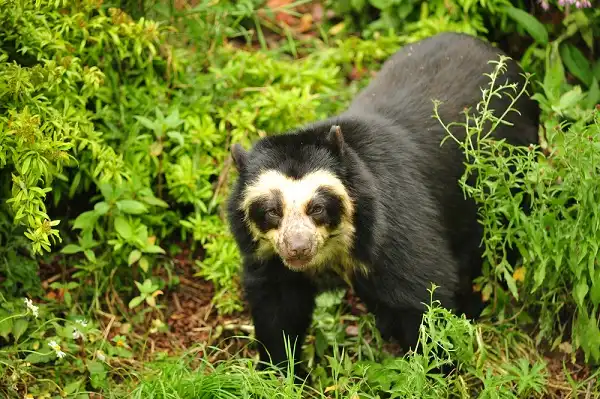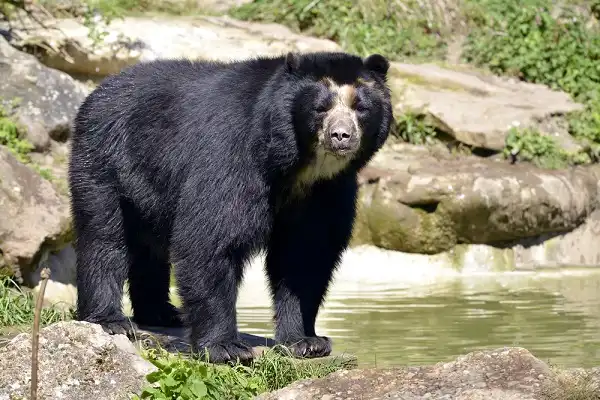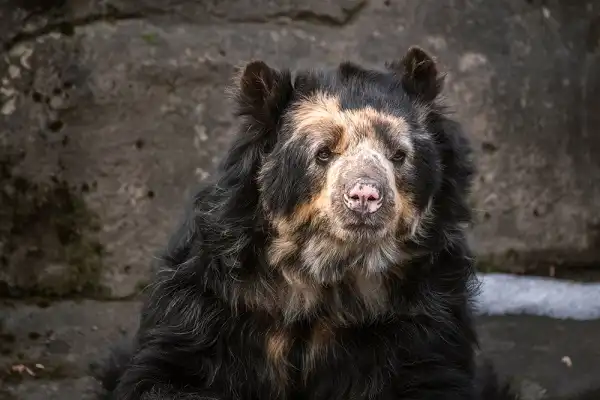Do you ever find yourself daydreaming about mysterious creatures of the wilderness? Fascinating and elusive, these animals have been known to captivate people’s attention and imagination – none more so than South America’s own Spectacled Bear! This mysterious creature has played an important role in various cultures throughout its historical range. From a shamanic connection with some indigenous tribes in Peru to being featured as a mythological being in Spanish colonial literature, this bear is much more than meets the eye. Read on to learn more about the fascinating biology and ecology of this one-of-a-kind species.

Spectacled Bear Description
The spectacled bear have short, dense fur that ranges in color from black to reddish-brown or tan with white patches around their eyes resembling glasses. They also have short, rounded ears, a long snout and a large head relative to their body size. Spectacled bears are usually solitary animals and can be found in various habitats including tropical forests, cloud forests, grasslands and scrublands.
Spectacled Bear Habitat
Spectacled bears are found in the Andes Mountains of South America, which span through Venezuela, Colombia, Ecuador, Peru and Bolivia. They inhabit a variety of habitats throughout these countries including tropical forests, cloud forests, grasslands and scrublands. The most important habitats for spectacled bears are mountain forests located at altitudes between 2,000-4,000 meters above sea level.
Spectacled Bear Diet
Spectacled bears have an omnivorous diet that consists of nearly 70 different species of fruits and vegetation. Some favorite foods include figs, guavas and other wild berries as well as tubers from underground stems or roots. Spectacled bears also feed on insects such as ants and beetles, as well as small mammals, birds and the occasional reptile or amphibian.

Spectacled Bear Size
The average size of a spectacled bear is usually between two and three feet tall at the shoulder. However, females tend to be smaller than males. Spectacled bears are known for their smaller stature compared to other species of bears as well as their strong climbing abilities. They have long, curved claws on their front paws which help them to grip onto tree trunks and branches, allowing them to reach high into the treetops in search of food or shelter.
Spectacled Bear Lifespan
The lifespan of the spectacled bear is typically between 20 and 25 years in the wild. However, in captivity, these bears may live for up to 30 years. Compared to other species of bears, spectacled bears have a relatively short lifespan due to risks from predators, human hunting and habitat destruction. Spectacled bears reach sexual maturity at around 2-3 years of age, and their breeding season usually takes place between August and October. After a gestation period of 6-7 months, female spectacled bears usually give birth to one or two cubs which remain with the mother until they are between 1 and 2 years old. During this time they are heavily dependent on her for protection as well as learning crucial survival skills such as finding food and avoiding predators.
Spectacled Bear Behavior
Spectacled bears are typically solitary animals, with each bear occupying a home range of around 6 to 12 square kilometers. They search for food during the day but rest and sleep at night in dens that they build in hollowed out trees or rocky crevices. These den sites are typically located high above the ground and often overlooked by predators due to their camouflaged entrances. One interesting behavior exhibited by these bears is their vocalizations which include growls, groans, coughs and grunts when communicating with other members of their species. Additionally, they are known to make loud barks when threatened or startled as well as making huffs and puffs when trying to scare away potential threats.

Spectacled Bear Speed
The spectacled bear is one of the slowest-moving species of bear, but it has impressive agility and climbing ability. It moves at a slow walk or trot, reaching speeds of up to 5 mph (8 km/h) while on the ground. However, when in trees it can move much faster and climb vertically up trunks with remarkable speed. This fast movement allows them to quickly escape any potential danger that may be lurking below in the foliage. Overall, even though these bears move slowly on the ground they are more than capable of escaping predators thanks to their excellent tree-climbing skills! Spectacled bears have adapted extremely well to living in forests and this makes them incredibly efficient climbers who can move around the treetops with ease.
Spectacled Bear Hunting
Spectacled bears are opportunistic feeders, meaning they will take advantage of any food source that is available to them. In the wild, this may include fruits and other plant matter as well as small animals such as lizards and rodents. Additionally, these bears have been known to hunt larger prey such as deer, capybaras and even livestock! Unfortunately, hunting by humans has greatly impacted spectacled bear populations in the past few decades due to the demand for their fur and meat. This has forced many of these animals into captivity either in zoos or circuses which can be detrimental to their health and wellbeing.
Spectacled Bear Threats
The spectacled bear is listed on the IUCN red list of threatened species due to habitat loss and degradation from human activities such as agricultural expansion, logging and climate change. In addition, these bears are killed illegally for their fur or used in traditional medicine trade. Conservation efforts are necessary to protect this species from extinction.

Conclusion
The spectacled bear is a unique species of bear found in South America that has adapted to its environment over thousands of years. In order to prevent any further decline, it is important that conservation efforts continue so future generations can marvel at the beauty of this majestic creature!
Frequently Asked Question

